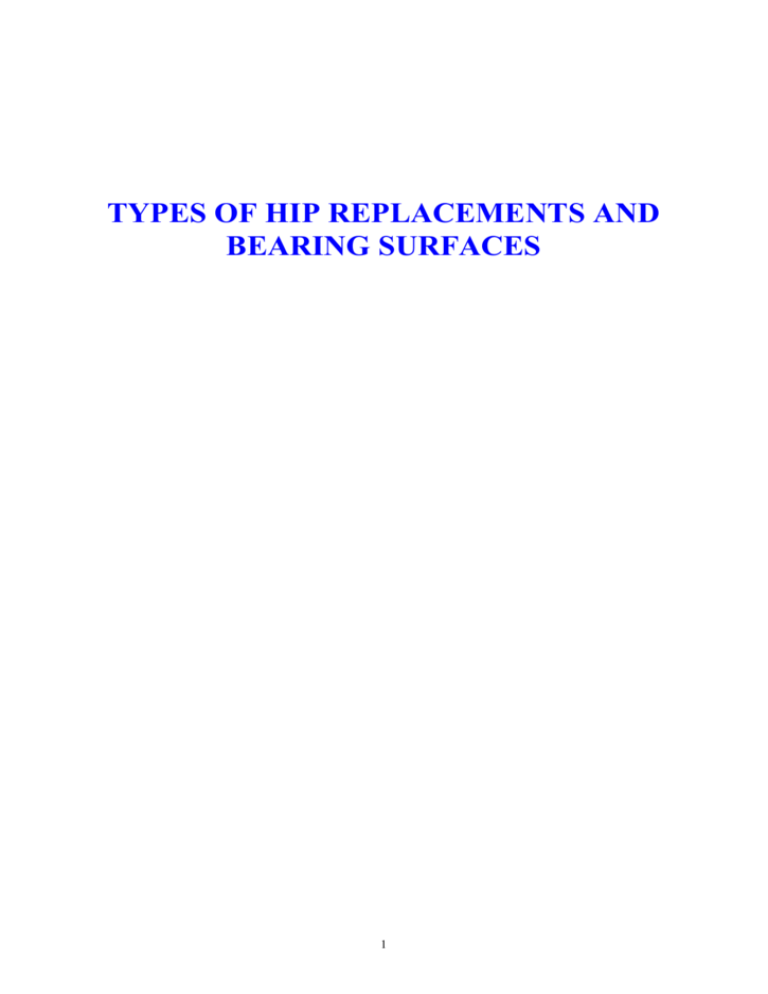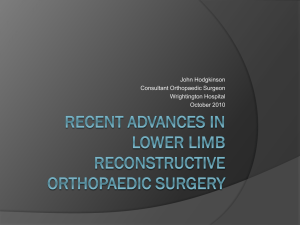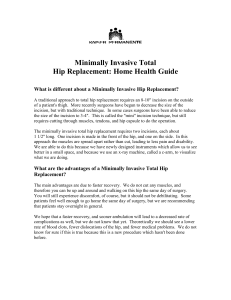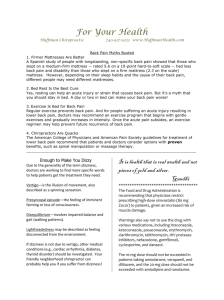MR G - Rapid recovery hip replacement
advertisement

TYPES OF HIP REPLACEMENTS AND BEARING SURFACES 1 PATIENT INFORMATION SHEET TYPES OF HIP REPLACEMENTS AND BEARING SURFACES Hip replacement is a highly successful procedure in the majority of cases, but occasionally the artificial joint will fail. There are two main modes of failure of a hip replacement: 1. Loss of fixation between the artificial joint and your bone (often called aseptic loosening). 2. Wear of the bearing surfaces, which may cause debris that, in turn, may precipitate loosening of the replacement. Research is continuing so as to minimise these risks and there are now a number of different types of replacement available. However no single type of replacement is better than another and not all replacements are suitable for all patients. The decision as to which replacement is best for you is complex and dependent on a number of factors; your surgeon will discuss this with you. Currently there are three main types of replacement, categorised by the way the replacement is fixed to bone. These types may be further categorised by the bearing surfaces that they employ. (1) Cemented Hip Replacements This is the type of hip replacement that first came into common clinical usage in the 1960s; they are the most tried and tested with the longest clinical results. The arthritic head of the femur (the ‘ball’ of the hip joint) is removed and replaced by a metal ball that is fixed by means of a stem that is inserted into the shaft of the femur. The socket of the hip is lined by a polyethylene cup. Both components are held in place by a plastic cement called polymethy methacrylate. 2 An example of a Cemented hip Replacement The Metal Stem and Plastic Socket An X-ray showing it in place There are a number of such cemented hip replacement designs that have clinical results of over 20 years; Exeter, Charnley and Stanmore are just some of the designs you may have heard about. How long do they last? It is impossible to guarantee how long an individual’s replacement will last, but many studies have shown that in general: 95% will last 10 years 70-75% will last 20 years 60-70% will last 20-25 years. Thus it is unlikely that older patients will require any further surgery. However in younger patients who tend to be more active there is a greater chance that these hip replacements will wear out. Sometimes even before 10 years. It was initially thought that the polymethyl methacrylate cement was the problem and so uncemented hip replacements were designed. 3 (2) Uncemented Hip Replacements. The design of these replacements is similar to that of cemented replacements with the exception that no cement is used. A special coating is applied to the stem that encourages bone to grow into the replacement. The plastic socket fits into a metal liner that also has a special coating. An example of an Uncemented Hip Replacement The Metal Stem with coating An X-ray showing it in place There are now good long-term follow up data on these types of replacement. Results up to 10 years are equivalent to cemented replacements and there are suggestions that they may be giving better results up to 15 years. Very longterm results over 20 years however are not yet available. Despite these good results this type of replacement may not be suitable for all patients. Because they depend on bone ingrowth they may not be indicated in patients who have osteoporosis or have rheumatoid arthritis; in these patients a cemented replacement may be more appropriate. 4 (3) Hip Resurfacing Hip Replacements. Although the idea for hip resurfacing is not new, the ability to make a successful model is very recent. This type of hip replacement uses a metal socket like an uncemented hip replacement socket, but with no plastic liner. Instead of cutting off the femoral head (the ‘ball’ of the hip) the surface is milled and covered with a metal cap that fits over the head. It is not suitable for everyone and in general is considered a replacement for younger people. The advantage is that the bone is preserved, theoretically reducing the chance of dislocation and therefore allowing greater activity. The bone within the hip has to be very good quality (no osteoporosis) as there is a small risk of fracture to the neck of the femur below the metal cap. The operation is slightly bigger as more tissues have to be cut; this can make recovery longer. An example of a Hip Resurfacing Hip Replacement The Metal Socket and Metal Cap An X-ray showing it in place In the short term the results are equivalent to conventional hip replacement. However there are few published results beyond 7 to 8 years and some remain of the opinion that the case for this replacement has yet to be proven. 5 BEARING SURFACES The ideal bearing for an artificial hip would have the following qualities: 1. It would have a diameter similar to that of the normal hip, thereby reducing the risk of dislocation 2. It would have minimal friction 3. It would show minimal wear with time Unfortunately there is no manmade bearing that meets all these criteria and compromises have to be made. The available options are as follows: (1) Metal Ball / Polyethylene Socket. The traditional hip bearing is a plastic socket with a metal ball. To reduce the amount of wear in the socket the ball needs to be made quite small and this increases the chance of the hip dislocating. Furthermore even with a reduced head diameter there is significant wear of the plastic cup after 10 years. This will cause debris which may lead to loosening of the hip. This has prompted the search for better bearing surfaces. (2) Altered Polyethylene Socket – The plastic cup may be made stronger by using ‘highly cross-linked polyethylene.’ Laboratory studies have shown promising results, but clinical results are awaited. One possible concern is that whilst being stronger this type of polyethylene is more brittle and might therefore be more prone to break up. (3) Ceramic Head / Polyethylene Socket. The artificial ball may be made of ceramic which reduces both friction and wear when tested in the laboratory. This theoretical advantage has yet to be shown in clinical 6 studies. One further concern is that early models of ceramic head occasionally shattered causing an immediate catastrophic failure of the hip replacement. Recent design of ceramic head do not appear to be as prone to this form of failure. (4) Ceramic Head / Ceramic Socket. With the ceramic ball and sockets there is very little if any debris produced but there is a very rare risk of the ball fracturing with catastrophic failure. At present for technical reasons the ball cannot be made as large as the metal balls so there is a theoretical higher risk of dislocation. (5) A Metal Head / Metal Socket. Theoretically a metal on metal articulation appears to confer significant advantages. Wear is minimal and the articulation may be made large reducing the risk of dislocation. The downside however is that a small amount of metal from this articulation will dissolve causing an elevation the level of metal ions (particularly cobalt and chromium) in the patient’s blood stream. There is a theoretical risk that this may affect the body over a long period of time and possibly increase the risk of cancer. The risk however would appear to be extremely small since metal implants have been commonly used in orthopaedic practice over the last 50 years and to date there has been no increased incidence of cancer observed. It is possible that severe metal allergy might be problematic with this type of bearing although to date this has not been reported. Minor metal reactions however are not really a significant concern. 7 CONCLUSION: Research continues to try and find an artificial hip that will allow normal activity and will last a lifetime. Cemented hip replacement will allow almost normal activity and is likely to last in excess of 10 years; it is hoped that modern replacements will last even longer. However it is unlikely that a hip replacement will ever be quite as durable as a normal hip and it is sensible to take some simple precautions. Activities that you would be expected to be able to do after hip replacement are:(1) Walking (2) Swimming (3) Cycling, exercise bike or normal bicycle (4) Golf (5) Visiting the gym. But……..patients should avoid impact activities such as running and any high impact aerobics (although aqua-aerobics is acceptable). We do not advise badminton or squash, although gentle ‘doubles’ tennis is possible. People who are experienced skiers can consider skiing again. The use of most gym machines is safe; in fact exercising in a non-impact way is very important. 8 Further Information:National Joint Registry (NJR) website http://www.njrcentre.org.uk/ National Institute for Health and Clinical Excellence (NICE) http://www.niceguidance.org.uk/ NHS Website http://www.nhs.uk/ British Orthopaedic Association Website http://www.boa.ac.uk/ North Hampshire Hospitals NHS Trust www.northhampshire.nhs.uk 9






